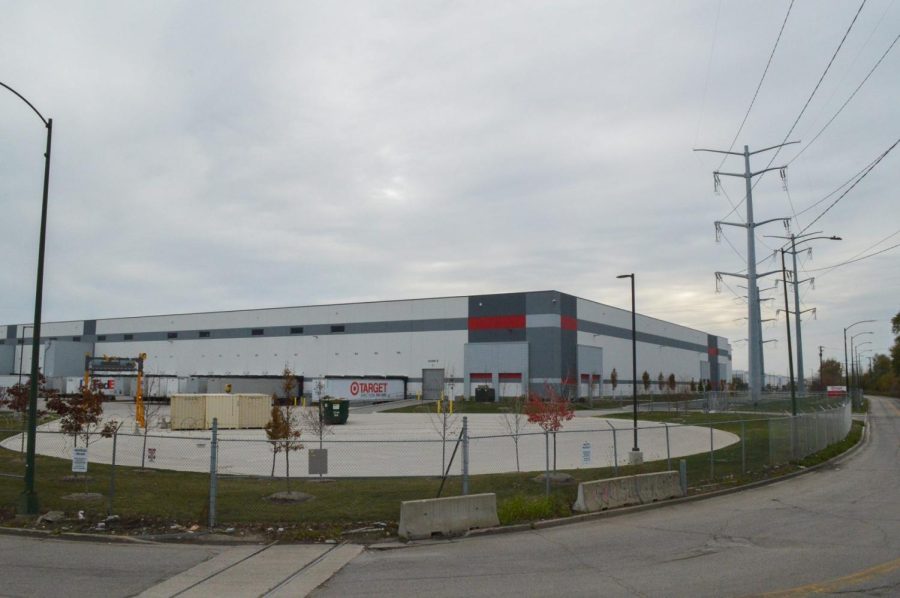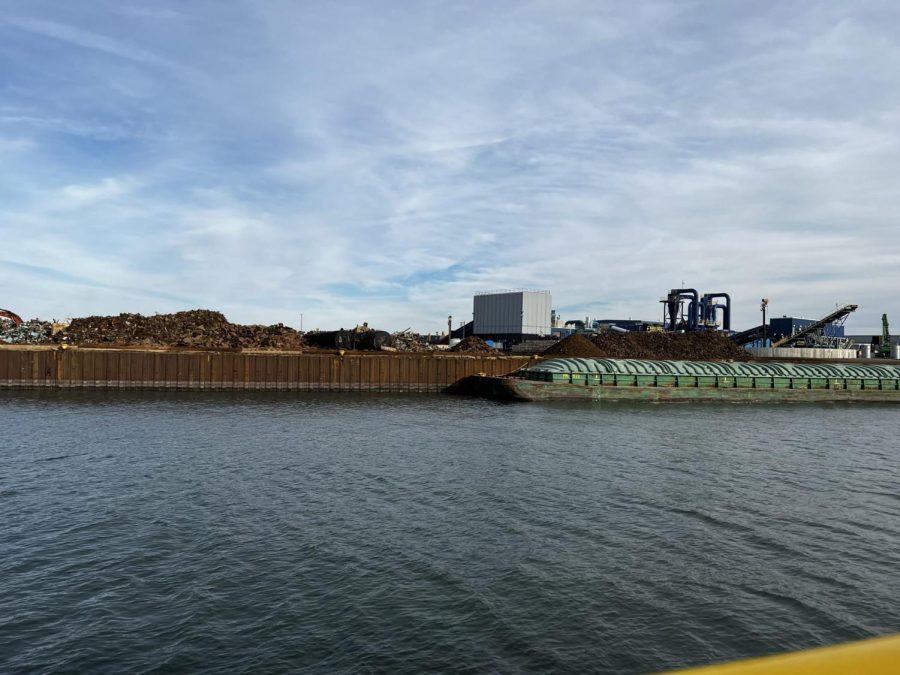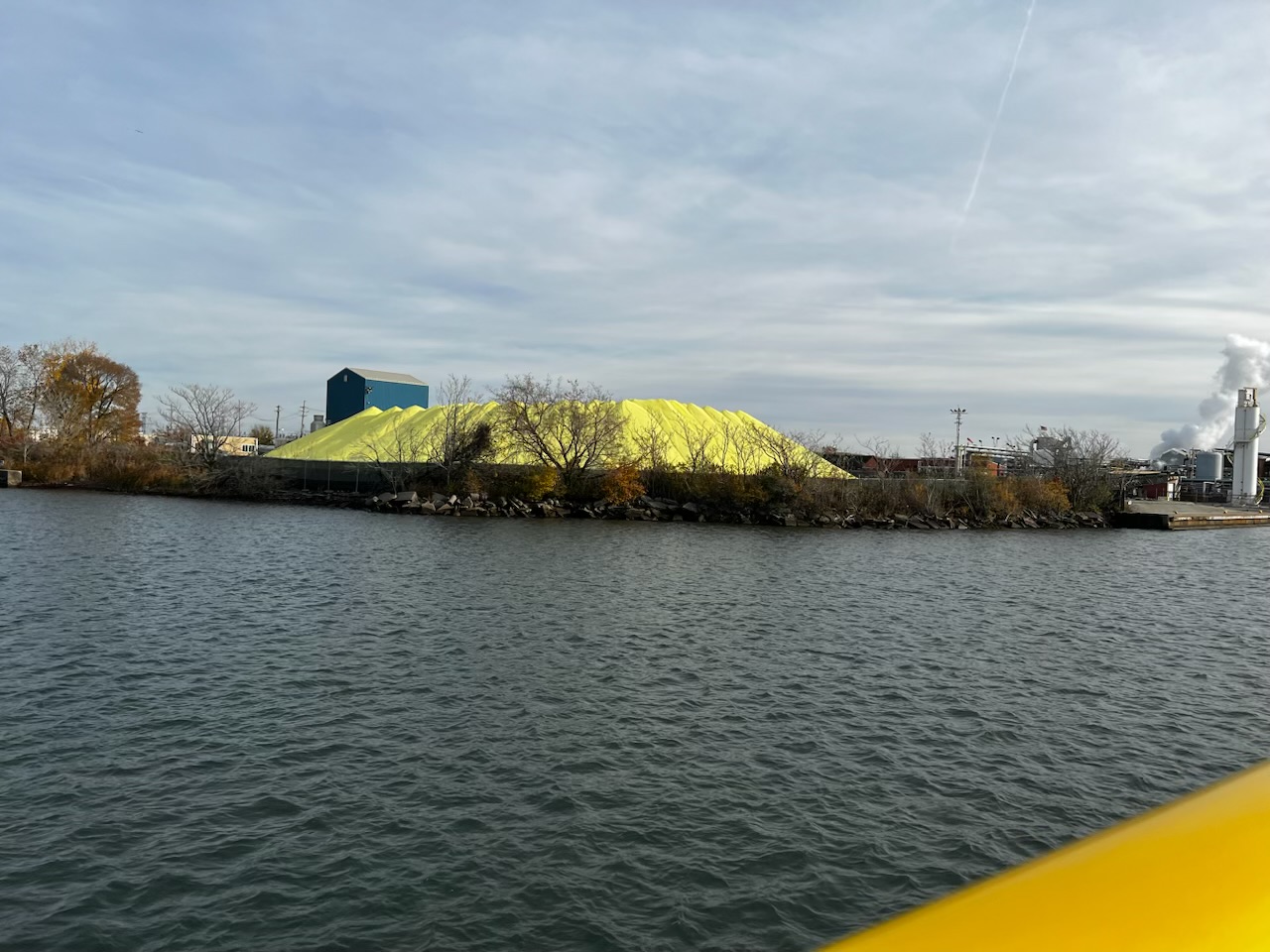‘I don’t think [we] deserve to live like this’: For South Side residents, the fight for environmental justice is far from over
January 23, 2023
Between the South Side of Chicago and Gary, Indiana, lies one of the most polluted waterways in the United States, the Calumet River. The 8-mile stretch of river is home to industries like metal manufacturing, cement production, material waste, recycling plants and more.
Maria Maynez, the youth organizer for Alliance of the Southeast’s (ASE) youth leadership council who has grown up on the Southeast Side of Chicago most of her life, recently took a boat tour along the murky river where she witnessed firsthand how much industry affects the area near her home.
Maynez lives in South Chicago near the western Indiana border and said there is a metal shredding facility a few blocks away from her home on 106th. Until she went on the tour, she said she never realized how sizeable the mounds of metal were.
“When I look at it from maybe a block away, it kinda just looks like one little mountain of metal,” Maynez said. “But there’s always something happening there, there’s always a fire, there’s always an explosion, especially in the summer when it gets really hot.”
According to Maynez, there are countless more piles of scrap metal from various manufacturers in a span of two miles near her home.

Maynez is not the only Chicago resident burdened by the environmental impacts of industry. Environmental hazards mark the landscape of Chicago’s South East and West side communities, where residents experience the effects of industrial pollution in their land, water, and even air, breathing in the toxic fumes from diesel trucks and factories daily.
Maya Rodriguez, an outreach coordinator for Illinois Senator Robert Peters (D-13), said South Side residents have dealt with the impacts of industry for years, yet it seems like people have only started to care in recent years.
“I think there’s a sense of hopelessness that exists in people who live over here sometimes,” Rodriguez said. “You’ve been consistently let down by the city, by the state, by the federal government. [The] fight for environmental justice has existed for many, many years, and only feels like people care about it now because it’s going to change the neighborhood and revitalize it.”
According to an air quality and health report conducted in 2020, residents on the Southeast Side breathe some of the city’s dirtiest air contaminated with particulate matter that has detrimental health effects.
Pollutants overwhelm the Southwest Side too. A city planning report from 2019 found that South Lawndale encounters a higher burden of air pollution relative to the rest of Illinois. Additionally, 95% of the Illinois population experiences equal or less exposure to PM 2.5, a harmful particulate matter caused by diesel pollution, than those in southern Chicago.
Exposure to toxic pollutants and heavy industry also has detrimental effects to resident’s health. The city health report shows exposure to increased levels of pollutants such as ozone and PM 2.5 is associated with increased risk of respiratory problems, asthma, cancer and even early death. PM 2.5 is also found in the exhaust of diesel vehicles which is prevalent in the Southeast Side.

Despite city data that acknowledges the South Side as environmentally overburdened, activists claim that these areas continue to experience the harsh effects of discriminatory zoning and land-use policies.
“The South and West sides of Chicago are heavily impacted by toxic industry, and not coincidentally, those are also minority neighborhoods,” Amalia NietoGomez, the executive director of ASE said. “Minority neighborhoods in the city of Chicago are overwhelmingly environmentally burdened compared to majority white areas.”
In April 2020, Hilco Redevelopment Partners faced a lawsuit after it demolished the former Crawford Power Plant smokestack causing a particulate dust cloud from the implosion that engulfed the homes of Little Village residents.
Following the implosion, Mayor Lori Lightfoot issued a letter to Hilco demanding action to clean up the area around the site.
Now, a 1.3 million-square-foot Target distribution center resides at the former Crawford coal plant site.

In 2020, community activists filed a complaint claiming the city perpetuates environmental racism by intentionally pushing industrial polluters from wealthier, North Side neighborhoods to low-income, minority communities on the South Side.
The complaint prompted a two-year investigation by the U.S. Department of Housing and Urban Development (HUD) after General Iron Industries, a scrap-shredder with a long-history of polluting problems on the North Side, was set to leave Lincoln Park to relocate to the Southeast Side in 2020.
Although the city denied the permit for General Iron to relocate on Feb. 18, 2022, NietoGomez claims it took three and a half years of community organizing efforts and a hunger strike for this to happen.
According to NietoGomez, this was due to the Illinois Environmental Protection Agencies’ (IEPA) lack of investigation into General Iron’s history of violations and noncompliance during the permitting process. She said the IEPA also did not provide translation services or take into account the total amount of pollution already existing in the Southeast Side.
In July, a letter to Lightfoot showed HUD sided with the advocates. If the city failed to reform its zoning and land-use policies, which HUD determined are racially discriminatory, the agency could withhold millions of dollars of federal funding.
NietoGomez believes cumulative, impactful legislation is the first step in ensuring environmental hazards preexisting in South and West side communities are taken into consideration during the permitting process. Although she said it is not enough to ensure the Southeast Side does not continue to have to fight environmental injustices.
“It’s a really important policy that we need, but it’s really not groundbreaking,” NietoGomez said. “If the [General Iron] permit had been denied, then we would not even be dealing with the permit at the city level. If this could be decided earlier in the process, we wouldn’t have had to have these fights.”

House Bill 4093, also called the Environmental Justice Act, advanced to the Illinois Senate in March 2022. If passed, the law would reform antiquated zoning and permitting processes for industrial facilities in the state.
To Rodriguez, cumulative impact legislation will assist Chicagoans in the fight for environmental justice, even if there are not visible changes right away. She believes it is not about the people alive right now but is for the next generation, and will create a better way of life for all families in the South Side.
“What is the point in trying to inspire your kids, the younger generation to expect better if you, yourself, continue to give up?” Rodriguez said.
Rodriguez said she continues to fight for environmental justice because giving up is not an option when people have the ability to combat these injustices.
“I do not think that you or I deserve to continue to live like this,” Rodriguez said. “Do you really want to choke on this air? Do you really want to be concerned about things in the ground, things in the water? We can use [cumulative impact legislation] to make sure it stops, and yes it may take time, but it’s better to do this than do nothing. We can’t let it affirm a sense of hopelessness.”
Environmental justice activists believe the bill is promising as it would ensure the IEPA reviews the history of a company including whether they have past violations or a history of compliance before approving a permit. It also requires the IEPA to look at the cumulative impact or how much pollution already exists in the area of relocation, along with providing translation services if required and making sure a third party has standing in the permitting process.
Reforms included in the Environmental Justice act:
- Recognizes cumulative impacts of industry
- Expands public and community participation by requiring in person, public hearings for permits
- Creates the first definition of environmental justice in the Illinois Environmental Protection Act
- Empowers grievance procedures that would allow any person or community that has been discriminated against by the IEPA to file a complaint and provide standing to impacted communities to challenge a siting permit in court
- Requires large air pollution facilities go through the same local siting process that landfills use to get sited, increasing ability for community input
- Creates a project bank for fines and fees incurred in environmental justice communities
- Require environmental justice assessment for cumulative impact for any new pollution source in an environmental justice area
- Extend deadlines required by the IEPA for permit approval, and the IEPA would be required to deny permits for previous environmental violations given by any body of government
According to NietoGomez, one of the primary benefits of the act is the resulting community input given during the permitting process. Right now, the only people that can file a lawsuit is the IEPA itself or the company applying for a permit.
“The community currently does not have standing to file a lawsuit,” NietoGomez said. “The community needs to be at the forefront of deciding whether or not this makes sense. There needs to be a process where the community can advocate for themselves.”
During the fight to block the General Iron permit, Southeast Side communities conducted their own Health Impact Analysis (HIA) to prove how industrial waste was affecting their communities.
Harmful health effects plague residents near large industrial sites on the South Side that result from pollutants like ozone, manganese, sulfur and arsenic. These pollutants primarily come from large industrial sites, landfills, recycling centers, steel manufacturers and trucking facilities according to data in the 2020 air quality and health report.
“For General Iron, we had community scientists [and] we became our own researchers because the IEPA wasn’t providing it [and] the company certainly wasn’t providing it,” NietoGomez said. “We have high rates of cancer, we have high rates of asthma, we know it’s affecting us.”
NietoGomez believes that although they won the fight against General Iron, the task should have been easier. During the HIA process, there were three community meetings and only one where residents were allowed to give input. The amount of attendees was also limited, according to NietoGomez.
“We can’t keep fighting this development by development, and it’s not fair to the communities that keep having to have the same fight over and over again,” NietoGomez said.
The ASE, along with other environmental justice organizations, continue to fight the permits for the relocation of industrial developments on the Southeast Side.
“Many times this community has been promised stuff and it has been failed,” Rodriguez said. “Something needs to be done about environmental justice in this area, and if cumulative impacts are going to help that, then…people need to understand because it’s all of us, not just me believing in this…it’s everyone. It isn’t about giving up.”
Currently, NietoGomez said the ASE has been fighting the Confined Disposal Facility, located on the lakefront near Calumet Park at the mouth of the Calumet River where they pull toxic dredgings from the waterway. The group is also battling The Invert, an underground mining project proposed by construction materials company Ozinga Bros. Inc. on a toxic site located near area residences. As of now, NietoGomez said both proposals are moving forward.
“You keep putting toxic developments here, stop it,” NietoGomez said. “We thought when we had the General Iron victory that would change things, but since then, Sims Metal is still moving forward, MAT Asphalt is still moving forward. This is not okay and this needs to stop.”

karltonepps1@gmail.com / Jan 24, 2023 at 6:57 am
MrGood
Terence Nugent / Jan 23, 2023 at 11:55 am
Industry is the reason the southeast side exists. This is not an identity politics issue. The hearty industries such as steel that formed the economy of the area predate the current demographics.
Driving out industry will have a horrendous economic impact on an already benighted region.